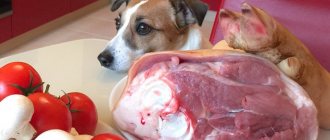Can dogs be given raw meat? The answer to this question is very controversial. There are as many supporters of such a feeding system as there are opponents. Arguments claiming that unprocessed meat has undoubted benefits sound very convincing. As well as those who say that raw meat is potentially harmful to a pet’s health. To understand which meat better satisfies the need for nutritious food, and to properly organize balanced feeding for your pet, you need to understand the basic physiology of the dog’s body.
Beneficial properties of meat for dogs
Many owners of four-legged animals notice that when meat products are included in the animal’s diet, its condition improves greatly: the dog becomes cheerful and cheerful, stool normalizes, muscles appear and endurance increases.
This occurs due to the introduction of meat foods into the diet, which:
- helps to form muscle and bone tissue;
- improves the condition of the skin, teeth and claws;
- acts as a source of energy.
When purchasing meat, you should choose low-fat varieties, because such food is easily digested, benefiting the animal. Eating foods with large amounts of fat and lard provokes gastrointestinal diseases.
Raw or cooked
If you observe the process of food absorption by a dog, you will see that it does not chew food, but actually swallows it. A dog's saliva does not contain enzymes, so the digestion process begins directly in the animal's stomach.
Nature has designed the dog's digestive system in such a way that it can easily digest a piece of raw meat. The acidity level of gastric juice allows you to quickly soften muscle fibers. The stomach muscle strongly compresses food, aiding the digestion process.
In addition, meat is a source of protein, the consumption of which provides energy and improves the general condition of the animal.
Thus, it is inherent in nature that a dog should eat meat. Then the question arises: in what form should I use it: raw or boiled?
Let's highlight the advantages of the raw product:
- Cheese contains an optimal balance of proteins, fats and carbohydrates. During heat treatment, it will lose many useful substances. The dog will most likely eat boiled meat with great pleasure. But the owner will have to take a more responsible approach to preparing the diet, using a more diverse range of additives.
- Raw meat and offal do not contain preservatives or flavoring additives. This is an excellent solution for animals that are prone to allergic reactions.
- Since raw has more protein, satiety occurs faster. A portion of a raw product compared to a cooked one will be two times smaller.
As for bones, they are necessary. However, they should only be given raw. The dog’s stomach will not be able to digest a boiled bone, causing constipation and pain.
If meat is used from trusted suppliers who guarantee its safety and the absence of parasites, then it is given raw. Anything else should be boiled or excluded.
Each owner makes his own choice of what to feed his pet. And it will depend on many factors.
Harm and contraindications
Despite the benefits of meat, if used incorrectly, it can cause harm to the animal.
The product can be a source of various diseases if it is not stored properly. There are varieties that should not be given to dogs:
- pork - it is fatty, which is why it is poorly digestible;
- veal - excessive consumption provokes diarrhea;
- chicken - can be infected with bacteria or filled with antibiotics;
- Duck or goose meat is fatty, so it is recommended for consumption in small quantities;
- river fish is prohibited due to the likelihood of infection with worms and injury to internal organs by bones.
Some types of meat should not be given to dogs.
Representatives of certain breeds are prone to meat allergies. This:
- Labradors;
- dachshunds;
- Dalmatians;
- Shar-Pei;
- Shepherd dogs.
Most often, allergies are caused by chicken, sometimes by rabbit, beef and veal.
It is forbidden to give dogs sharp tubular bones, which, if they enter the digestive tract, can injure the walls of internal organs.
Properties of different types of meat
Among the varieties, there are those that are useful for pets, and those that are best not included in the four-legged menu. By comparing the disadvantages and advantages of different types, the owner can choose the right option, taking into account the needs of the dog.
Pork
There is a lot of debate about the benefits of pork. The body of pigs is designed in such a way that they eat everything, while practically not sweating, retaining toxins inside. These animals are often carriers of helminths or tapeworms.
Dogs love pork very much, so they are given piglet meat.
However, domestic dogs love pork, so veterinarians allow feeding piglets meat. The main thing is that the tenderloin is not fatty - this can cause a deterioration in the dog’s well-being. Excessive consumption of this species will lead to excess weight and pancreatitis, so it should not be given to puppies of decorative breeds and dogs prone to obesity.
Pork can be fed to street dogs, but only in winter. Before serving, the product is cooked until tender.
Beef
Beef is the most beloved and popular food among four-legged animals. It is recommended by experts because it contains many vitamins, including quality protein and organic iron. It is better to give dogs beef trimmings - it is easily digestible and has a positive effect on the intestines. Cartilage stores gelatin, which strengthens bones and joints.
Mutton
Lamb is a good food for dogs of any age. It contains:
- B vitamins, which strengthen muscles and improve the functioning of the nervous system;
- potassium and magnesium, which have a positive effect on the cardiovascular system.
Lamb is suitable for dogs of any age.
horsemeat
Horse meat is included in the list of approved foods for dogs because it is high in protein. However, it should not be given to the dog too often - horse meat is low in fat, the deficiency of which has a bad effect on the dog’s energy. Many owners note that their pets do not like the taste of horse meat.
Bird
Poultry is often found in the diet of dogs because it has an affordable price. But store-bought broiler carcasses may contain dangerous drugs, so you should buy chicken from trusted sellers.
Dogs are often given poultry meat due to its affordable price.
Turkey meat is rich in vitamins A, E, D, PP. Thanks to its high retinol content, it stimulates the immune system and supports healthy metabolism. Due to its low fat content, it can be used in dietary nutrition.
Rabbit
Rabbit meat contains vitamins B and C. It is low in calories and has a beneficial effect on the gastrointestinal tract.
Rabbit meat is not recommended for older dogs or those suffering from kidney disease.
Venison
Venison is considered a healthy delicacy, but it is expensive - not everyone can afford such a pleasure. This type of meat contains a lot of protein and B vitamins, so occasionally you can pamper your pet with tasty and nutritious venison.
Venison is considered a delicacy for dogs.
Thanks to the special diet of wild deer, their flesh cannot be infected with worms. Therefore, it is safe to feed raw venison to dogs.
By-products
Among by-products, tripe is considered the most useful.
It contains many vitamins, thanks to which the dog’s digestion is normalized and regeneration is accelerated. If the animal has a powerful jaw, it itself will be able to tear the scar into pieces. Small breed dogs should cut the treat into pieces. The product is not recommended for puppies under 2 months of age. Beef liver is a source of folic acid, a deficiency of which leads to damage to the mucous membranes and anemia. Eating beef heart helps compensate for the lack of magnesium and phosphorus.
Cow udder is given to dogs that exercise a lot and are active throughout the day. This offal will help build muscle, because... contains a lot of collagen and elastin.
Lamb spleen is rich in iron, but it is included in the diet with caution - in large quantities it provokes diarrhea.
All offal, except liver and tripe, are heat treated before serving. You can feed your animal with them no more than 2 times a week.
What type of meat is best for dogs?
When introducing meat into your diet, it is important to take into account the characteristics of each variety.
This will help you correctly create a menu based on the needs of the animal’s body. If a dog requires dietary nutrition, it is recommended to feed it turkey, chicken, and rabbit. For healthy adult dogs, beef or lamb is suitable. It is important to ensure that there are no fatty layers in the meat.
It is recommended to give dogs meat without fatty layers.
Veterinarians advise buying beef or beef tripe - they are healthy and safe for your pet’s health. When introducing a new meat variety into the diet, it is necessary to give it in small quantities, observing the condition and behavior of the dog. If allergies, bowel problems, nausea or lethargy occur, use should be discontinued.
Is it possible to feed it to a dog all the time?
For dogs, meat is the most nutritious product included in the daily menu, containing microelements important for health. Periodically, dogs are given meat by-products (liver, ventricles, hearts, etc.). With a natural diet, it is important to achieve food balance; the main food is supplemented with cereals, vegetables, fruits, dairy products, and vitamin supplements.
Take the Attention Test! Find 10 differences! (click right here!)
Find the answer Are you bothered by some problem or question? Enter “Breed” or “Name of the problem” into the form, press Enter and you will find out everything about the issue that interests you.
High-quality ready-made dry food eases the burden of dog owners, contains a complex of vitamins and minerals necessary for animals, and eliminates the need for dietary variety. Each owner chooses a feeding method based on the personal capabilities and needs of the pet.
In what form should the meat be given?
The debate about whether dogs can eat raw meat or whether it is better to heat-treat it first has been going on for a long time. Moreover, each point of view has its own arguments for and against.
Pros and cons of raw meat
Dogs are able to obtain nutrients from raw meat.
Adherents of this feeding note that when cooked, food loses some of the protein and minerals that are important for the dog’s health. Also, the boiled product contains more carbohydrates, as a result of which the animal becomes hungry again after a short time. If the owner decides to feed the dog raw meat, it is important to follow the following rules:
- The piece is scalded with boiling water to destroy bacteria, or frozen for 1-3 days.
- The bones are removed so that the dog does not injure the jaw and teeth. Fat is cut off - this will help avoid health problems.
- The meat is given in large pieces - then the animal will be able to tear it, cleaning and strengthening the teeth.
Pros and cons of boiled meat
Proponents of processed foods argue that raw food can be dangerous.
Boiled meat loses a lot of vitamins.
Uncooked cuts may contain harmful microorganisms, unlike cooked meat. And although after cooking it loses most of its vitamins, they can easily be replenished with cereals and vegetables.
Veterinarians advise giving some varieties only boiled. These are wild livestock and poultry. The kidneys and liver are scalded with boiling water or boiled to prevent the dog from becoming infected with pathogenic viruses.
Should I give jerky?
Jerky should only be fed to your dog as a treat for following a command or being obedient. This product causes extreme thirst, so the animal should always have fresh water freely available.
What's harmful?
Not everything in the world is equally useful. This axiom is also true for our little brothers. There are products that will not bring any benefit, and often cause great harm, causing, at best, an upset stomach, and at worst, serious diseases of the internal organs.
Unhealthy food:
- Pork . Too fatty and heavy for a dog's digestive system. Their ancestors have never encountered anything like this, which means their stomachs simply cannot digest this type of product and get what they need.
- Lard and pieces with fatty layers will also have an extremely negative effect on the absorption of nutrients.
- All kinds of chemical and vegetable substitutes , for example, soy.
- Sausage, frankfurters, sausages and other store-bought human “delicacies”. The animal eats them with pleasure, but they are made for people, taking into account their preferences. Such products contain salt and spices, which are extremely harmful. Specific processing methods and all kinds of chemical additives will also not add any benefit.
- Prepared for humans . Unless you are an opponent of spices and prefer to cook exclusively by steaming, do not share your dinner with your pet, even if he is actively begging. A piece from your plate will only harm your pet.
- Fried, baked, smoked or otherwise prepared meat is considered “dead” to the dog. The amino acids it needs have been destroyed, and protein will be poorly absorbed. But dried or dried pieces of beef without spices can be given out as a treat.
In what form should you not give meat to dogs?
Veterinarians do not recommend using minced meat. It is poorly absorbed, negatively affecting intestinal function.
Minced meat is not recommended for dogs.
You should not give your dogs spoiled meat, especially one with an unpleasant odor or strange color.
If the owner has doubts about the freshness of the product, it is better not to risk it. It is prohibited to feed the animal fried, stewed or baked meat.
Allergy to meat in a dog
There are frequent cases of allergies in dogs to a certain type of meat. Allergic symptoms are standard and include:
- itching, rash, redness, peeling, hair loss;
- discharge from the eyes, ears, nostrils;
- swelling of the muzzle, some parts of the body, mucous membranes;
- labored breathing;
- unpleasant odor;
- frequent stool.
Any food can cause similar symptoms. Each organism has its own characteristics; representatives of the same breed have different reactions to specific foods. When introducing an innovation to the diet, it is important to monitor the pet’s condition; food that provokes allergic symptoms is excluded from the menu.
In some cases, blocking allergic symptoms requires the use of medications - hormonal, antifungal, antihistamines, antibiotics and other drugs. Drug elimination of the consequences of allergies occurs under the supervision of a veterinarian.
Rules for cooking meat for dogs
Some types of meat must be processed before feeding. However, this must be done following the cooking rules.
Cooking time
During cooking, the meat decreases in size by 3 times, and part of the protein goes into the broth, so you should take a raw piece 3 times larger than normal.
The cooking time depends on the size and type of meat and is at least half an hour. The time may be increased since the product must be completely cooked. The dog is not given ready-made broth, but you can cook delicious porridge with it.
Using spices
When cooking, do not use salt or any other spices. They negatively affect the quality of food and provoke liver and stomach diseases in the dog and impair the acuity of smell.
The use of spices provokes the development of stomach diseases.
Can puppies and pregnant women eat meat?
For normal growth and development, protein is required, contained in meat and some other products; the need for protein in a puppy is greater than in an adult animal. Your pet's natural diet should be balanced and varied. Puppies are accustomed to solid food after weaning from their mother's milk; usually the bitch feeds the babies no longer than a couple of months. For the first meat feeding, chicken, rabbit, veal or beef are used, later the puppy is introduced to other types of food - lamb, turkey, horse meat, etc. The product is served defrosted, cut into small pieces; trimmings are absorbed by the dog's gastrointestinal tract better than minced meat. From the age of three months, large beef bones are given (necessarily raw), dogs gnaw out bone substance containing calcium and other important minerals, periodic gnawing of bones serves as a kind of teeth cleaning and prevention of tartar and plaque. From six months, by-products are added to the natural diet. The dog may have an individual intolerance to some types of meat, so new food is introduced gradually in small portions, monitoring the body’s reaction.
The nutrition of a pregnant bitch should be complete and healthy. During pregnancy, the need for various nutrients and sufficient caloric content of food increases. When feeding with ready-made food, the portions increase; when feeding with natural food, the diet is adjusted and a vitamin complex is added. Protein is important in the first stage of gestation; vegetable protein cannot replace animal protein, so meat is always present on the menu of a dog expecting offspring. At a later stage, the amount of protein received should be reduced and meat dishes limited.
What to Consider When Calculating Portion Sizes
In large quantities, even healthy foods can be harmful. You should carefully calculate the portion for the animal, taking into account its needs and condition.
Breed of dog
When calculating, it is important to take into account the breed of the dog.
If she belongs to representatives prone to obesity, then meat should be given with caution, recording the pet’s weight. In case of a sharp increase in body weight, the serving size should be reduced. Representatives of large breeds that are active require more meat than small dogs.
Weight and age
You can feed your pet raw meat from an early age. The product is introduced into the diet in small daily portions - at first it is advisable to feed the puppy stroganin, and then gradually increase the size of the piece.
Meat can be given to dogs from an early age.
For energetic adults, the norm is 3-4% of body weight. For the elderly, it is reduced to 2-2.5% of the mass. Puppies need increased volume - their norm is 6%.
Lifestyle
An active animal should receive about 30 g per 1 kg. If the dog is inactive and does not like to run, then 15-20 g per 1 kg of weight is enough for such individuals. This amount should be divided into 2 feedings.
Health status
If the dog suffers from diseases of the gastrointestinal tract or other organs, then the portion size and menu are developed individually. To do this, contact a veterinarian - he will suggest the right foods, create a diet and give recommendations on feeding.
What can you combine meat with in your dog’s diet?
Raw or cooked meat can be combined with the following cereals:
- Buckwheat contains useful substances, so when consuming this porridge, you can exclude vitamin supplements from your dog’s diet. Promotes normal development of puppies, does not cause allergies.
- Rice - helps remove toxins and waste from the body, and relieves pain in case of irritable bowel syndrome. Not recommended for animals suffering from diabetes or obesity.
- Oats are rich in microelements, vitamins and antioxidants. It is not suitable for all breeds, so for the first time the animal is given a small portion of porridge to check the reaction.
You can combine meat with buckwheat.
Cereals that negatively affect the health of four-legged animals:
- semolina;
- millet;
- pearl barley;
- corn;
- barley
In addition to cereals, the animal’s diet is supplemented with fresh vegetables and fruits:
- carrots;
- cucumber;
- pumpkin;
- zucchini;
- banana;
- pear;
- apple
Experts advise adding chicken and quail eggs to food no more than 2 times a week, no more than 1-2 at a time. Low-fat dairy products, such as cottage cheese, kefir and cheese, are good for your dog's health and strengthen bones.
Briefly about the main thing
- The dog is a carnivore, its digestive system is prepared by nature to feed on raw meat;
- The animal's menu can consist of both raw and cooked products;
- Cheese contains more protein, fat and carbohydrates. A smaller portion is required for complete saturation;
- You can use different types of meat products, observing the reaction of the animal’s body;
- Chicken and other birds are given boiled;
- Treat your pet to offal and raw tripe twice a week;
- The meat is cut into pieces, the bones are given only raw.











